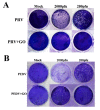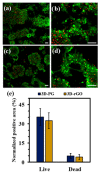Flake Graphene as an Efficient Agent Governing Cellular Fate and Antimicrobial Properties of Fibrous Tissue Engineering Scaffolds-A Review
- PMID: 35955241
- PMCID: PMC9369702
- DOI: 10.3390/ma15155306
Flake Graphene as an Efficient Agent Governing Cellular Fate and Antimicrobial Properties of Fibrous Tissue Engineering Scaffolds-A Review
Abstract
Although there are several methods for fabricating nanofibrous scaffolds for biomedical applications, electrospinning is probably the most versatile and feasible process. Electrospinning enables the preparation of reproducible, homogeneous fibers from many types of polymers. In addition, implementation of this technique gives the possibility to fabricated polymer-based composite mats embroidered with manifold materials, such as graphene. Flake graphene and its derivatives represent an extremely promising material for imparting new, biomedically relevant properties, functions, and applications. Graphene oxide (GO) and reduced graphene oxide (rGO), among many extraordinary properties, confer antimicrobial properties of the resulting material. Moreover, graphene oxide and reduced graphene oxide promote the desired cellular response. Tissue engineering and regenerative medicine enable advanced treatments to regenerate damaged tissues and organs. This review provides a reliable summary of the recent scientific literature on the fabrication of nanofibers and their further modification with GO/rGO flakes for biomedical applications.
Keywords: antimicrobial properties; electrospun scaffold; graphene modifications; polymeric biomaterials; tissue engineering.
Conflict of interest statement
The authors declare no conflict of interest.
Figures












Similar articles
-
Nanofibrous silk fibroin/reduced graphene oxide scaffolds for tissue engineering and cell culture applications.Int J Biol Macromol. 2018 Jul 15;114:77-84. doi: 10.1016/j.ijbiomac.2018.03.072. Epub 2018 Mar 16. Int J Biol Macromol. 2018. PMID: 29551508
-
Fabrication, Characterization, and Biocompatibility of Polymer Cored Reduced Graphene Oxide Nanofibers.ACS Appl Mater Interfaces. 2016 Mar 2;8(8):5170-7. doi: 10.1021/acsami.6b00243. Epub 2016 Feb 15. ACS Appl Mater Interfaces. 2016. PMID: 26836319
-
Aligned PLLA nanofibrous scaffolds coated with graphene oxide for promoting neural cell growth.Acta Biomater. 2016 Jun;37:131-42. doi: 10.1016/j.actbio.2016.04.008. Epub 2016 Apr 7. Acta Biomater. 2016. PMID: 27063493
-
Graphene Incorporated Electrospun Nanofiber for Electrochemical Sensing and Biomedical Applications: A Critical Review.Sensors (Basel). 2022 Nov 9;22(22):8661. doi: 10.3390/s22228661. Sensors (Basel). 2022. PMID: 36433257 Free PMC article. Review.
-
Cell-matrix mechanical interaction in electrospun polymeric scaffolds for tissue engineering: Implications for scaffold design and performance.Acta Biomater. 2017 Mar 1;50:41-55. doi: 10.1016/j.actbio.2016.12.034. Epub 2016 Dec 21. Acta Biomater. 2017. PMID: 28011142 Review.
Cited by
-
Effect of the Addition of Graphene Flakes on the Physical and Biological Properties of Composite Paints.Molecules. 2023 Aug 21;28(16):6173. doi: 10.3390/molecules28166173. Molecules. 2023. PMID: 37630425 Free PMC article.
References
-
- Bleeker E.A.J., de Jong W.H., Geertsma R.E., Groenewold M., Heugens E.H.W., Koers-Jacquemijns M., van de Meent D., Popma J.R., Rietveld A.G., Wijnhoven S.W.P., et al. Considerations on the EU Definition of a Nanomaterial: Science to Support Policy Making. Regul. Toxicol. Pharmacol. 2013;65:119–125. doi: 10.1016/j.yrtph.2012.11.007. - DOI - PubMed
-
- Kreyling W.G., Semmler-Behnke M., Chaudhry Q. A Complementary Definition of Nanomaterial. Nano Today. 2010;5:165–168. doi: 10.1016/j.nantod.2010.03.004. - DOI
-
- Jacob J., Haponiuk J.T., Thomas S., Gopi S. Biopolymer Based Nanomaterials in Drug Delivery Systems: A Review. Mater. Today Chem. 2018;9:43–55. doi: 10.1016/j.mtchem.2018.05.002. - DOI
Publication types
Grants and funding
LinkOut - more resources
Full Text Sources

